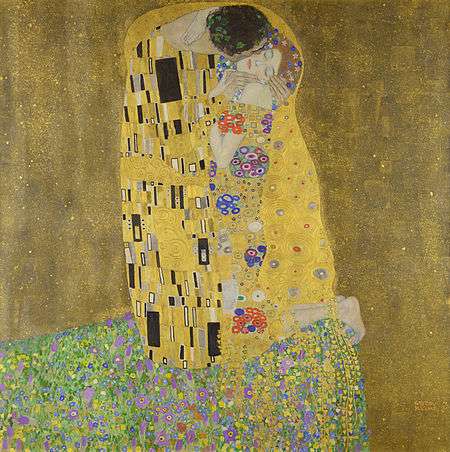Emilie Louise Flöge
Emilie Louise Flöge (30 August 1874 in Vienna – 26 May 1952 in Vienna) was an Austrian fashion designer, and businesswoman. She was the life companion of the painter Gustav Klimt.
Life and business career

an oil painting by Gustav Klimt
She was the fourth child of the master turner and manufacturer of Meerschaum pipes, Hermann Flöge (1837–1897). Emilie had two sisters, Pauline and Helene, and a brother, Hermann.[1]
Her first job was as a seamstress, but she later became a couturière. In 1895, Pauline, her elder sister, opened a dressmaking school and Emilie worked here. In 1899 the two sisters won a dressmaking competition and were commissioned to make a batiste dress for an exhibition.
In partnership with her sister Helene, after 1904 Emilie established herself as a successful businesswoman and the owner of the haute couture fashion salon known as Schwestern Flöge (Flöge Sisters) in one of the major Viennese thoroughfares, the Mariahilfer Strasse. In this salon, which had been designed in the Jugendstil by the architect Josef Hoffmann, she presented designer clothing in the style of the Wiener Werkstätte. During her trips to London and Paris she familiarised herself with the latest fashion trends from Coco Chanel and Christian Dior, however, after the Anschluss with the German Third Reich in 1938, Flöge lost her most important customers and had to close her salon, which had become the leading fashion venue for Viennese society. After 1938 she worked from the top floor of her home at 39 Ungargasse.
Association with Gustav Klimt
Emilie Flöge was a member of the Viennese bohemian (Bohemianism) and Fin de siècle circles. She was the life companion of the painter Gustav Klimt. In 1891, Helene, the older sister of Emilie, married Ernst Klimt, the brother of Gustav Klimt. When Ernst died in December 1892, Gustav was made Helene's guardian. At that time Emilie was eighteen years old and Gustav became a frequent guest at the home of her parents, spending the summers with the Flöge family at Lake Attersee.[1]

After 1891, Klimt portrayed her in many of his works. Experts[2] believe that his painting The Kiss (1907–08) shows the artist and Emilie Flöge as lovers.
Klimt also drew some garments for the Flöge salon in the rational dress style - a style promoted by the feminist movement - and from 1898, other clothes designed by the Vienna Secession; the latter were worn without a corset and hung loosely from the shoulders with comfortable, wide sleeves. The clientele for what was at that time a revolutionary fashion was too small to provide a living, however, and she earned money accordingly through conventional styles. Klimt was painting many ladies from the upper echelons of Viennese society and thus, was able to introduce Emilie Flöge to a prosperous client base.
Klimt died from a stroke on 11 January 1918. His last words reportedly were, "Get Emilie". She inherited half of Klimt's estate, the other half going to the painter's family.[1]
In the final days of the Second World War, her house in the Ungargasse caught fire, destroying not only her collection of garments, but also valuable objects from the estate of Gustav Klimt.
Popular culture references
Emilie Flöge is the first-person narrator of the historical novel The Painted Kiss by Elizabeth Hickey, published in 2005.
In the 2006 film Klimt, Emilie Flöge was played by Veronica Ferres and Gustav Klimt by the American actor, John Malkovich.
Notes and references
- 1 2 3 "Schönheitsideale & Ornamentik - Damen der Gesellschaft". Museum online. 1996. Retrieved 2011-02-25.
- ↑ Alfred Weidinger (art historian and vice director of Belvedere Museum Vienna) in interview in ORF broadcast "Klimt am Attersee", 26 Aug 2012.
Further reading
- Wolfgang G. Fisher with Dorothea H. Ewan (1997). "Gustav Klimt and Emilie Floege: An Artist and His Muse," Woman's Art Journal 17:2, p. 42.
- Hickey, Elizabeth (2005). The Painted Kiss: A Novel, Atria Books, New York, ISBN 0743492609 (Der gemalte Kuss, Bloomsbury, Berlin 2005, ISBN 3827006279).
- O'Connor, Anne-Marie (2012). The Lady in Gold, The Extraordinary Tale of Gustav Klimt's Masterpiece, Portrait of Adele Bloch-Bauer, Alfred A. Knopf, New York, ISBN 0-307-26564-1
Sources
This article is mainly a translation of the article in the German Wikipedia at de: Emilie Flöge with additional information from the French Wikipedia at fr: Emilie Flöge.
External links
- "Emilie Louise Flöge". Aeiou Encyclopedia (in German).
- Literature by and about Emilie Louise Flöge in the German National Library catalogue
- Additional images at http://www.klimt.com/en/gallery/photographies/details-emilie-floege.dhtml"Klimt Museum" commercial website